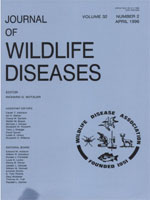Eighty-one barn owls (Tyto alba) and five Hawaiian owls or pueo (Asio flammeus sandwichensis) from Kauai, Oahu, Lanai, Molokai, Maui and Hawaii (USA) were evaluated for cause of death, November 1992 through August 1994. The most common cause of death in barn owls was trauma (50%) followed by infectious disease (28%) and emaciation (22%). Most traumas apparently resulted from vehicular collisions. Trichomoniasis was the predominant infectious disease and appeared to be a significant cause of death in barn owls in Hawaii. Pasteurellosis and aspergillosis were encountered less commonly. No predisposing cause of emaciation was detected. Stomach contents from 28 barn owls contained mainly insects (64%) of the family Tetigoniidae and Gryllidae, and rodents (18%); the remainder had mixtures of rodents and insects or grass. Three pueo died from trauma and one each died from emaciation and pasteurellosis. We found no evidence of organochlorine, organophosphorus, or carbamate pesticides as causes of death in pueo or barn owls.
How to translate text using browser tools
1 April 1996
CAUSES OF OWL MORTALITY IN HAWAII, 1992 TO 1994
Thierry M. Work,
Jon Hale

Journal of Wildlife Diseases
Vol. 32 • No. 2
April 1996
Vol. 32 • No. 2
April 1996
Asio flammeus
barn owl
disease
food habits
pathology
pueo
short eared owl




